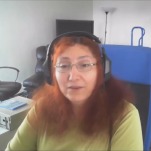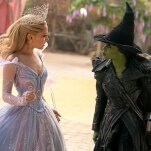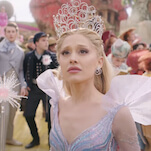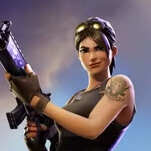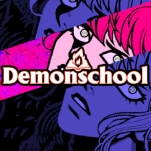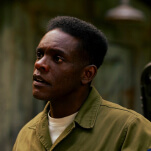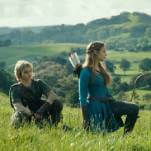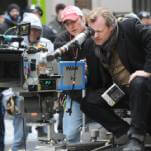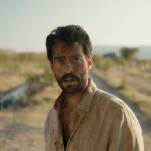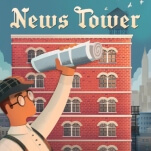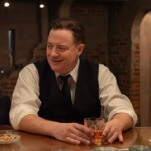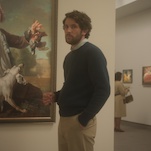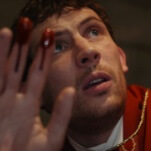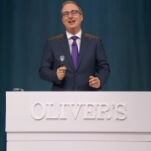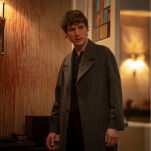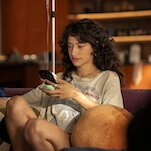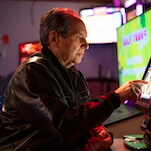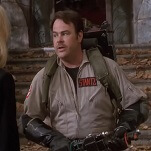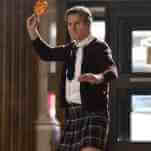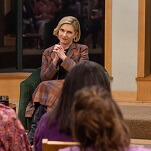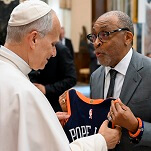ML: I realized over time, I wasn’t going to do a music film. That it was becoming a story about Jaye and Gen. That’s when I focused more on that.
AVC: Genesis, did you watch any of Marie’s previous short films?
GP: It was about three months before we saw anything, and then she brought me a couple of DVDs. One of them was the Kuchar brothers and another was, oh gosh, a theater person who slips my mind. Then we saw [Tony Conrad, DreaMinimalist], and it was Marie who introduced me to Tony, and that’s when we began playing violin together as well. We’ve done a few concerts together now, which is Marie’s fault. We played in Portugal, Germany, and America.
AVC: How does that music compare to the music you made with Throbbing Gristle and Psychic TV?
GP: It’s just myself on violin, and we have a very particular way of playing the violin anyway. It just split out from all of the other music, sort of a Jimi Hendrix of the violin is how we’d put it, because we use lots of psych pedals and echoes, and also sometimes played with two bows at the same time. We set it on a stand and play with a bow in each hand. Tony’s always a joy to work with. He has an amazingly empathetic way of playing that really slots into my way of playing. Neither of us are into an ego thing, so we stop playing when we don’t have something to say with the instrument. We don’t try to overpower each other. We both try and emphasize what the other is doing, so it becomes a really interesting flow. Now we have [PTV3 drummer] Morrison Edley playing percussion with us. When we thought we did everything we could think of, then it started all over again.
AVC: Late in the film, Lady Jaye tells you that you’ve already been a rock star, and there are other projects for you to do.
GP: Yes, she was always encouraging me to give up touring in a rock-band format because it was starting to exhaust me and make me sick. She felt it wasn’t really adding anything important to the body of work. It was fun, people liked it, but it wasn’t new enough. It wasn’t getting at something fresh. She was always trying to push me to work harder and think in more unusual ways to keep it interesting and have some sort of concept behind it. It would be too easy to keep going around as Throbbing Gristle and just doing the greatest hits, though it’s fun doing that. Any artist should stay challenged as long as possible. Even if they’re based in the same skill set, finding new ways to approach that and new ways of expressing the ideas you already had if you can’t have any new ones.
AVC: And the pandrogyne project is part of expanding those ideas?
GP: Oh yeah, definitely. Without Lady Jaye, it never would have happened. At the beginning, it was very intuitive. The first day we met, she took me back to her apartment to have some coffee and hang out and talk in the East Village on East 11th Street. Then she dressed me in all her clothes and took me to a Tibetan shop and bought all these little trinkets of bone and silver and wove them into my dreadlocks—I had dreadlocks then. She started to decorate me like her special unique Barbie doll from the very beginning.
AVC: And you met her in an unusual way, right?
GP: Yes, in a dungeon. We were living in California with my two children, halfway through a nasty divorce. We used to come to New York for a little downtime from having to look after two young children. We’d stay for a long weekend, and the person we’d stay with was Terence Sellers. She’s an amazing writer from that ’80s downtown New York scene. To make a living, she also ran a dungeon. People like Kathy Acker worked with her at the very beginning. Through her and seeing Terence give readings in London some years before coming to America, we got to become really good friends, and so we stayed with her. She had a small apartment next to her dungeon, which was her income source.
That’s where we met, me and Jaye. Jaye was working for Terence as a dominatrix part-time, and one day—it’s in the film—we’d been at Jackie 60, one of the best clubs New York has ever seen. Everybody that was in the underground, all the drag queens and performance artists and the writers, would all be there. Chi Chi, who ran it, was also really into poetry and literature, so she’d mix poetry readings with strange cabaret. She booked me a few times to give poetry readings there. We didn’t meet there, but Jaye was one of the original members of the Jackie 60 house of domination. We met because I was sleeping on the floor after a long weekend of being awake on ecstasy. I was under a white sheet, and some noises woke me up. We sat up in a dungeon amongst all the crosses, torture tables, and chains, and looked up at the doorway, and the space was open and lit. We saw Jaye walk across the doorway dressed in all original ’60s clothes, which we could tell, having been around in the ’60s.
AVC: Did you also see the dungeon in action?
GP: Yes, Lady Jaye and myself even worked in the dungeon as dominatrices together, which was interesting because we were booked as two female dominatrices, and clients didn’t know that we weren’t, I wasn’t a biological woman. So we got to see things that most people don’t get to see. It was fun. The hard part was to be really serious and try not to giggle. We didn’t want anyone to be offended or feel embarrassed.
AVC: Did anyone ever recognize you from Throbbing Gristle?
GP: No, nobody. Thank goodness. That would have been awful. In fact, we only did it together every now and then. It would depend on the clients. A lot of them were already blindfolded, so they don’t even get to see. It’s a very interesting experience that few biological males have had, I imagine.
AVC: How far along in the pandrogyne project were you when you were working in the dungeon together?
GP: Up until she passed away, we were still doing things together. From about 2005 to 2007, we worked together in the dungeon.
AVC: Did the dungeon sessions inform your creative work together?
GP: Not particularly. We were aware of that scene from many years ago. We used to go to clubs in London. Nothing about it was particularly new or unique information. It was done more for fun. It was relaxation, but of course, being dressed as a female dominatrix was obviously part of pandrogyne. It was interesting for me to see if we could carry the idea of “female” in something that intense and be convincing. It was a good sort of litmus test for how we were perceived.
AVC: The idea of transformation is a very powerful theme in the film. How do you currently identify at the moment?
GP: At the moment, well, the way we really look at it is, Lady Jaye is representing pandrogyne and the both of us in the immaterial dimensions, and we’re still here representing us both in the material dimensions. That’s how we perceive ourselves. My body now represents us both, and in a sense contains us both in this particular reality. That’s why when we’re talking about the more recent past, we use “we,” because we’re speaking of both of us. We talk to her all the time out loud about things, and when we drop something we say, ‘Sorry about that, bunny.’”
AVC: And that was the goal of the project, to become one?
GP: To become one, to be inseparable in every sense. The ultimate point for ourselves as individuals was, we wanted to find a way to be so powerfully connected that after physical death we would be able to locate each other’s spirit, soul, being, and reconnect. And being immaterial, literally becoming one consciousness.
AVC: In the film, Lady Jaye’s death is so abrupt. Did you know she was sick?
GP: She had stomach cancer for two years, but she decided, because she was a registered nurse, to see if she could get rid of it with diet. We both went on a raw-food diet together, and it was interesting. Just before, as she put it, she “dropped her body,” she was checked out by the doctors, and they said the cancer had shrunk so small that it was hardly there. It was just a tiny little dot. She actually conquered the cancer, but unfortunately they didn’t realize she had a heart condition that was somewhat related with the stress; she died of heart failure just really suddenly.
ML: I really didn’t know at all. It just happened in one day, and I came that night to see Gen, and it was totally shocking. It was so surreal, and to me, it was like the end of the film, because I didn’t feel like I wanted to interfere and respect Gen, who was so broken. I couldn’t bring my camera, but after a couple months, Gen actually asked me to keep filming in an homage to Jaye. And I did for two more years.
AVC: Your approach is much more personal than the classic cinéma-vérité style. How do you see your role as a documentary filmmaker?
ML: I don’t think there’s one vérité. I think whatever a documentary says is truth is never really truth. It’s one version of many truths. There are many scenes that are set up as tableaus where Gen is wearing costumes, or when I ask her to show me the archive, or the scenes I invented because of her stories. I wanted to set it up in that environment, so there’s collaboration there. Every time where there’s a song, Gen is wearing a bird or butterfly costume. These are more tableaux for me in terms of setting up the surreal quality of the film and the story. Taking you out of [Genesis’] kitchen to another level that’s like a dream sequence. I think it worked really well with Gen, who’s also like a measure of all these things. Layered to a point where you could lose yourself in fiction as much as reality.
